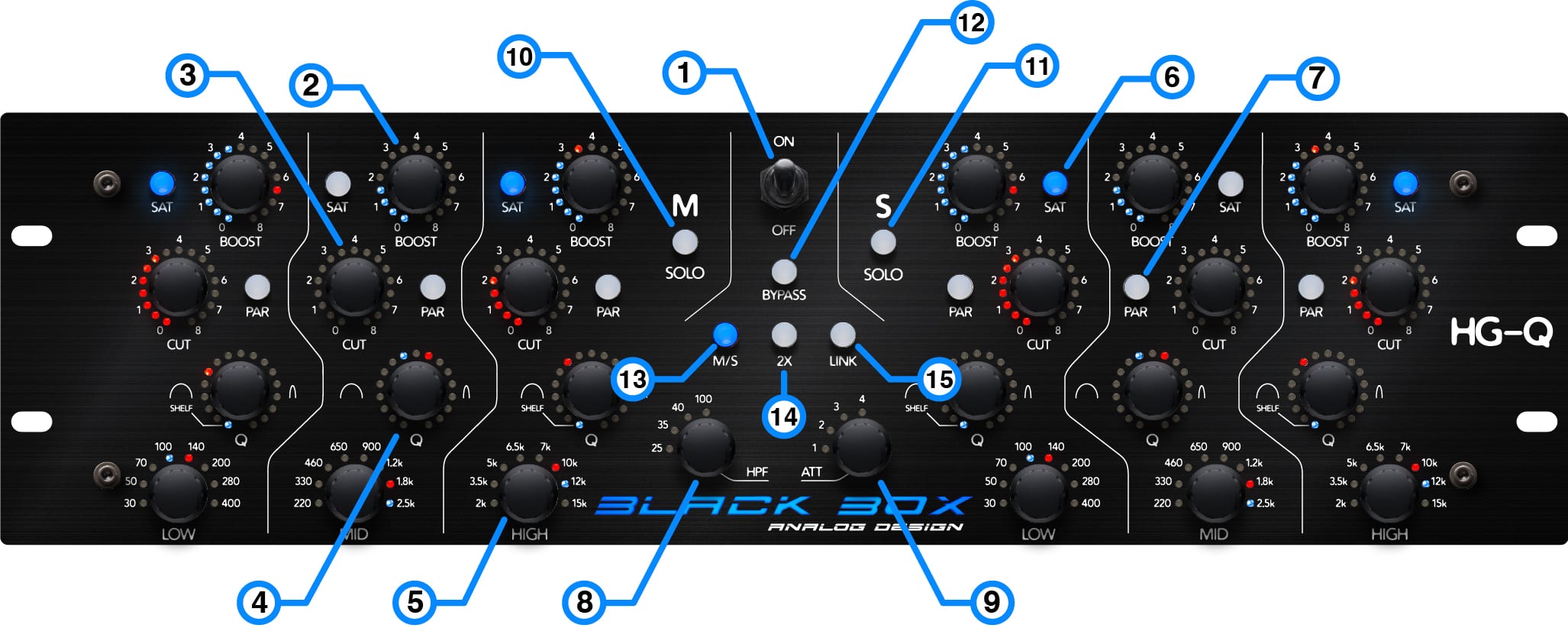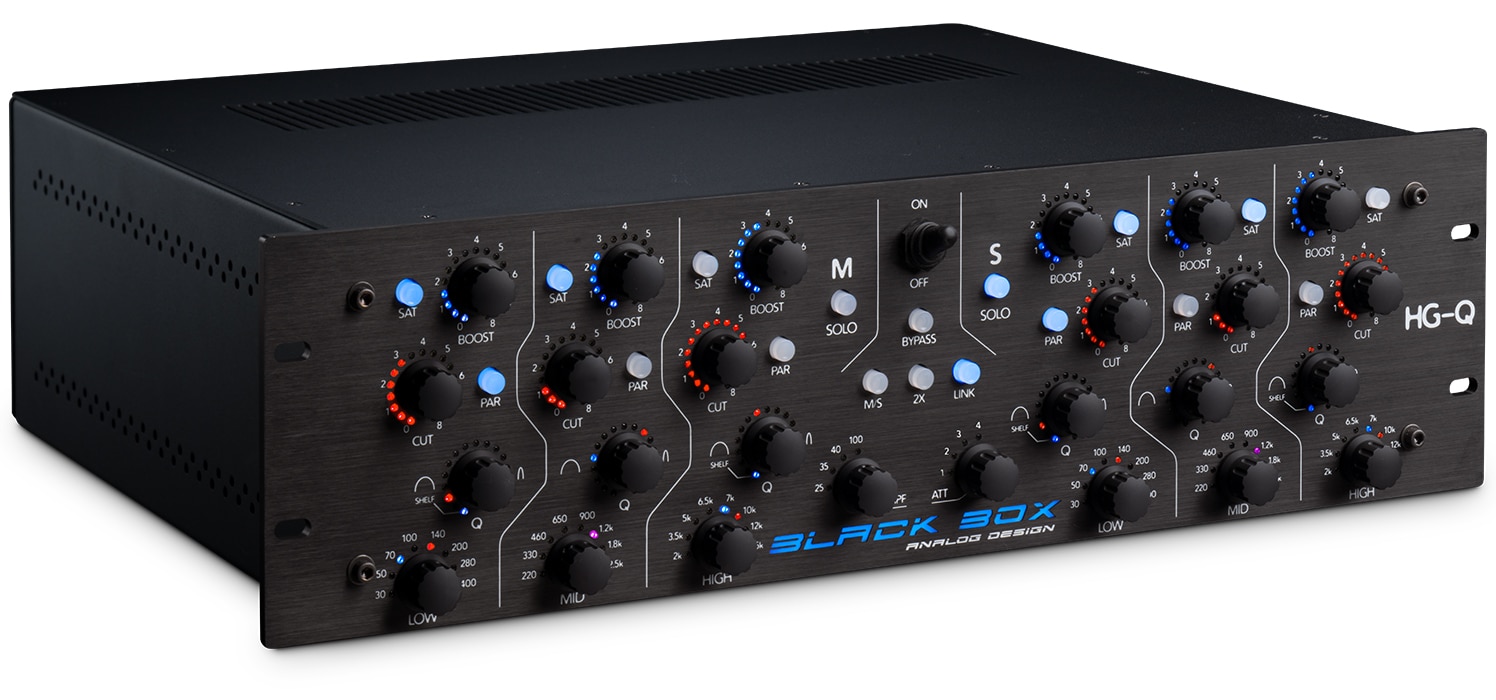I have yet to find a use that the HG-2 doesn't enhance
HG-Q
More than just an incredible EQ
The Black Box Analog Design HG-Q is a 3U boutique hardware EQ and saturator that offers digital plug-in control over its solid state and tube-driven circuitry. The HG-Q is a revolutionary creative powerhouse that reshapes and enhances your sound in ways traditional EQs could only dream of.
More than just an incredible EQ
The HG-Q combines unique topology, flexible tube saturation, and the ability to cut and boost simultaneously to create a totally new kind of audio enhancement tool.
This dual-mono, stereo, and M/S-capable EQ offers six fully independent and interactive bands for creative frequency shaping and sculpting, combined with acclaimed tube saturation circuitry that adds rich harmonic detail, depth and energy without compromising clarity — taking analog EQ and enhancement to a new level of integration and flexibility.
The saturation circuit in each boost band adds rich harmonic content without muddying transients or mix clarity. Unlike conventional saturation, the HG-Q’s circuit brings out lower-level details and enhances the mix’s density wherever you want it, all while leaving your transients, articulation and mix elements intact.
Get creative!
The heart of the HG-Q is a topology where the bands interact with each other in complex ways, allowing the HG-Q to deliver incredible sonic shaping well beyond the scope of traditional equalizers.
The 2X mode further expands the EQ’s range, allowing up to 16 dB boosts and cuts with intensified saturation that brings out every harmonic nuance. The result is a more cohesive, balanced, and musically engaging sound, achievable even at aggressive settings.
By boosting, cutting, adding saturation, and switching between series and parallel configurations, you will achieve wildly complex interactions and curves impossible on traditional EQs.
True analog processing with plugin control
Seamlessly linked with the hardware, the included HG-Q Control Plugin delivers plugin control over the hardware’s all-analog signal path. From creating, saving and recalling presets to automating parameters, the combination of hardware and Control Plugin gives you the best of both worlds!
The plugin even offers functionality beyond that of the hardware. The plugin only frequency curve display allows you to visualize boosts, cuts, saturation and the resulting combined response curves. An extended control view provides an expanded way of interacting with the controls with a dedicated knob for each function and control.

Controls

Click "+" for detailed description of each control
1. Power switch
On/Off positions.
2. Boost
This multilayer knob toggles between BOOST [gain] (solid blue led-ring) and SAT [level] (single red/purple LED) when clicked.
3. Cut
Turn to change the CUT [gain] of each band.
Pushing the CUT knob toggles the band Bypass which is indicated by active/inactive LED-rings.
4. Q
Sets the q-factor of the boost and/or cut circuit. When clicked, this multilayer knob toggles between Q [boost] (blue LED), Q [cut] (red LED), and Ganged Mode (purple LED when overlap) to setup the filters’ q-factor. The LOW and HIGH bands of each channel offer additional low/high shelf filters.
5. Frequency
Offers eight center frequencies in each band to choose from. When clicked, this multilayer knob toggles between boost frequency (blue LEDs), cut frequency (red LEDs), and Ganged Mode (purple LED when overlap).
6. Sat
Enables / disables an additional tube saturation in each boost circuit separately.
7. Parallel mode
When activated, the cut and boost circuits of the band are reconfigured from series (with the cut coming before the boost) to parallel, where both the cut and boost are fed from the same full spectrum input.
8. HPF
Select cutoff frequency of the high pass filters. Click knob to select left or right channel and Ganged Mode to link both frequencies while preserving their offset.
9. Output attenuation
Set to 0dB attenuation by default, the output level can be reduced to -4dB in 1dB increments. Click knob to select left or right channel and Ganged Mode to link both gains while preserving their offset.
10. Mid solo
Isolates the mid (sum) signal being processed.
11. Side solo
Isolates the side (difference) signal
12. Bypass
True bypass, shorts the input to output connections.
13. M/S mode
Dis-/Engages M/S processing. Set to On, the left channel processes the mid (sum) of both channels, the right channel processes the side (difference) of both channels.
14. 2X mode
Engaging 2X mode changes the gain ranges of the boost and cut controls from 8db in 0.5db steps to 16db in 1db steps.
15. Link
Switches linking of parameters between the channels on or off. When LINK is activated, all parameters from the left channel are immediately mirrored on the right channel. In LINK mode, both channel controls move together, regardless of which channel is being adjusted.
HG-Q Resources
For HG-Q resources including the HG-Q Control Plugin installer, user manual, update list signup and firmware updates,
Click here
VIDEO WALKTHROUGHS
Features:
-
Six Independent Bands per channel:
Each band provides separate boost and cut circuits with independent gain, Q, and frequency selection controls, allowing for flexible and musical interactions.
-
Dynamic Phase Interactions:
The unique analog topology creates complex phase interactions between bands, enhancing the harmonic relationship of frequencies in a mix. This approach allows for unique types of enhancements to bring out the best in sources.
-
Tube Saturation:
Integrated tube saturation stages within the boost circuits deliver harmonic richness, density and analog character, adding depth and dimension to any audio material.
-
Solid-State Precision:
Solid-state cut filters guarantee clarity and precision when removing problematic frequencies or when compensating for boosts.
-
2X Mode:
Engage 2X mode to double the control range of both boosts and cuts, enabling dramatic tonal reshaping with intensified harmonic saturation.
-
Flexible Operation Modes:
Seamlessly switch between stereo, mid-side (M/S), dual mono, and mono modes to adapt to any workflow or creative requirement. M/S processing opens up new dimensions for stereo imaging and control.
-
Analog Craftsmanship:
Encased in a 3U rack-mount chassis, the HG-Q combines reliability and modern design with classic analog aesthetics. Each unit is built to exacting standards, ensuring durability and performance in demanding studio environments.
-
Interactive Control:
With series and parallel configurations available, the HG-Q offers nuanced and dramatic ways to sculpt your sound, opening up endless possibilities for tonal experimentation and reshaping of sounds and mixes.
-
Comprehensive Visual Feedback:
Intuitive LED indicators and responsive displays provide immediate, actionable insights, streamlining the creative process while maintaining precision.
-
Hybrid Integration:
Seamless communication between hardware and plugin opens up entirely new possibilities and hybrid workflows.
-
Nothing Found!




